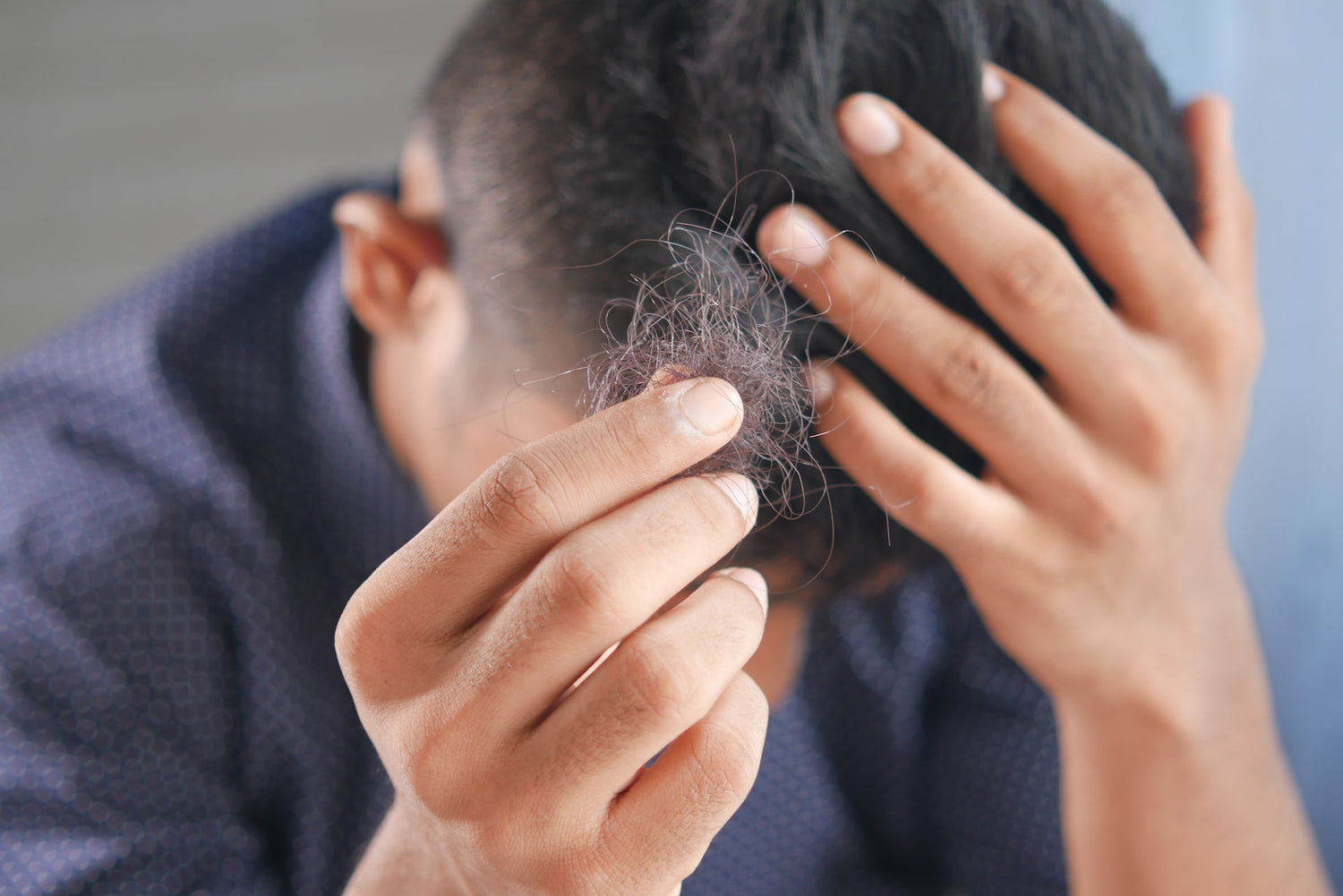Pyrilutamide (KX-826), a pharmaceutical compound designed with a specific therapeutic purpose, has become a subject of growing interest in the medical community. As with any medication, comprehending its nature, applications, and potential implications is very important before considering its use.
Pyrilutamide stands out for its unique properties and targeted applications which include managing specific medical conditions, preventing hair loss, influencing biological processes within the body, and more. In this post, we will particularly talk about Pyrilutamide and give you the knowledge required before using it so that you can make wise decisions.

Pyrilutamide and Its Primary Uses, with a Focus on Hair Loss
Pyrilutamide (KX-826) is a member of the pharmaceutical family. Pyrilutamide was invented by Kintor Pharmaceutical Limited, a company that is well-known for making innovative solutions for androgen receptor-related diseases like androgenetic alopecia, acne vulgaris, and certain cancers.
Originally developed for its anti-androgenic properties, Pyrilutamide has found significant application in the treatment of conditions influenced by androgen hormones, such as androgenetic alopecia, commonly known as male-pattern baldness.
Androgenetic alopecia, a prevalent form of hair loss, is characterised by a hereditary predisposition to the effects of dihydrotestosterone (DHT) on hair follicles. Pyrilutamide, through its anti-androgenic activity, works by inhibiting the effects of DHT – a hormone implicated in hair loss – thereby slowing down the progression of androgenetic alopecia.
Mechanism of Action
This drug acts as an androgen receptor antagonist, meaning it competes with and inhibits the binding of androgens like DHT to their respective receptors. By interfering with this binding process, Pyrilutamide mitigates the hormonal signals responsible for hair follicle miniaturization and eventual hair loss.
In simpler terms, Pyrilutamide acts as a protective shield for hair follicles and interrupts the chain of events that lead to their gradual deterioration. This mechanism is necessary in the context of androgenetic alopecia. It offers a potential solution for those seeking to retain and regrow their hair.
It is different from the commonly prescribed 5-alpha reductase inhibitors like finasteride and dutasteride. While both types of medications aim to address the impact of androgens on hair follicles, their mechanisms and potential side effects differ significantly.
5-alpha reductase inhibitors, including finasteride and dutasteride, work by preventing the conversion of testosterone to dihydrotestosterone (DHT). This reduction in DHT levels is essential in slowing down or halting the progression of androgenetic alopecia. However, these oral medications come with potential side effects.
Pyrilutamide, on the other hand, takes a unique approach as a topical anti-androgen. Unlike its oral counterparts, Pyrilutamide's clinical trials have shown that it does not lead to a decrease in systemic androgen levels. This is a key differentiator which indicates that Pyrilutamide is less likely to induce the adverse reactions commonly associated with oral 5-alpha reductase inhibitors.
The absence of systemic effects, such as changes in libido and mood, makes Pyrilutamide an intriguing option for those seeking an alternative to oral medications. The focus on topical application not only suggests a different avenue for intervention but also raises hopes for fewer side effects traditionally linked with androgenetic alopecia treatments.
Pyrilutamide Clinical Trials and Medical Indications
In September 2021, a pharmaceutical company named Kintor revealed promising results from its Chinese phase II clinical trial of Pyrilutamide, specifically designed for men grappling with androgenic alopecia, commonly known as male-pattern hair loss. This milestone was marked by success in both efficacy and safety. It is essential to note, however, that despite the positive outcomes, the lack of subsequent publication in scientific journals raises questions about the transparency and scrutiny of these findings.
The clinical trial, involving 120 Chinese men with moderate pattern hair loss symptoms classified under the Norwood-Hamilton scale as IIIv, IV, or V, explored various concentrations and application frequencies of Pyrilutamide. The study included three different options and two control groups:
- Pyrilutamide 2.5 milligrams (0.25% concentration) applied twice daily.
- Pyrilutamide 5 milligrams (0.5% concentration) applied once daily.
- Pyrilutamide 5 milligrams (0.5% concentration) applied twice daily.
According to information presented in a poster for the Annual Meeting of the Chinese Hair Research Society sponsored by the Chinese Society of Dermatology, the study found that the application of 5 milligrams of Pyrilutamide twice a day yielded the most significant improvements in hair growth. After 24 weeks of treatment, this regimen increased hair count by an impressive 22.73 hairs per cm². In comparison, the placebo group's hair count only experienced an increase of 15.34 hairs per cm².
Subsequent press releases from Kintor highlight positive outcomes from Pyrilutamide clinical trials in both female subjects and an American phase II trial for male pattern hair loss. These continuous affirmations of positive results underscore the potential significance of Pyrilutamide in expanding treatment options for individuals grappling with hair loss.
Preferred Method of Administration
Unlike some other medications used for hair loss treatment, Pyrilutamide is not taken orally or through injection. Instead, it is applied directly to the affected areas on the scalp. The choice of a topical application method can have practical advantages. This form of administration may enhance the drug's localized efficacy while reducing the risk of broader side effects commonly associated with oral medications.
How to Use Pyrilutamide for Hair Loss
When it comes to addressing hair loss with Pyrilutamide, the key lies not only in the efficacy of the solution but also in its optimal application. Follow these guidelines for effective and efficient use of Pyrilutamide:
Note: This instruction is made for our Hair Solution Pyrilutamide 0.5% (View Here)
Recommended Dosage:
- Apply a measured amount of 1ml to 4ml of Pyrilutamide solution to the affected area of the scalp daily.
- The specific dosage can be adjusted based on individual preferences and the severity of hair loss.
Timing of Application:
- Apply the Pyrilutamide solution in the morning.
- Nighttime application may lead to wastage as a significant portion of the solution can be wiped off the pillow during sleep.
Application Frequency:
- While some clinical studies have demonstrated the effectiveness of applying Pyrilutamide twice daily (morning and night), the majority of users experience success with only once-daily application in the morning.
- For individuals with severe hair loss, applying the solution twice daily may offer additional advantages. However, for most users, a single application in the morning is deemed sufficient.
Practical Considerations
- Make sure the affected area of the scalp is clean and dry before applying Pyrilutamide.
- The severity of hair loss and individual responses to the treatment can vary. For those with more pronounced hair loss, considering twice-daily application may be beneficial.
- It's recommended to start with once-daily application and, based on personal observations and preferences, adjust the frequency as needed.
Be Consistent
- Establish a consistent routine for applying Pyrilutamide. Whether in the morning or evening, choose a time that fits seamlessly into your daily schedule.
- Consistency in application is essential for maximizing the potential benefits of Pyrilutamide in promoting hair growth.
Personalized Consultation
- Consult with a healthcare professional for personalized advice on the optimal dosage and application frequency based on individual factors, including the extent of hair loss and any potential side effects. Or you can directly contact us and we will be available for you 24/7 for any queries you might have.
Potential Side Effects
While Pyrilutamide is efficient in treating hair loss, like any medication, it comes with potential side effects. Users must be aware of these effects, ranging from mild to severe, to ensure a safe and informed experience. Here, we detail the potential side effects associated with Pyrilutamide:
Common Side Effects
- Local Irritation: Some users may experience mild irritation or redness at the application site. This is a common reaction to many topical solutions.
- Dryness or Flaking: Dryness of the scalp or flaking skin may occur, particularly in the initial stages of usage.
- Itching: Mild itching on the scalp is reported by some users.
Less Common Side Effects
- Allergic Reactions: While rare, some individuals may experience allergic reactions to components of the Pyrilutamide solution. This can manifest as swelling, rash, or severe itching.
- Changes in Hair Texture: Some users have reported alterations in the texture of their hair, although this is not universally observed.
Severe Side Effects (Rare)
- Systemic Absorption Issues: Although clinical trials have suggested minimal systemic absorption, please monitor for any signs of systemic effects including changes in libido, erectile dysfunction, or mood swings.
- Unusual Hair Growth Patterns: In rare cases, users may observe unexpected changes in hair growth patterns.
Note: Regular monitoring of the scalp and overall health is recommended during Pyrilutamide use. If any side effects persist or worsen over time, seeking medical advice is a must.
Precautions and Warnings
It is essential to be aware of specific precautions and warnings to ensure the safety of diverse user populations. Specific precautions for certain populations are:
Pregnant and Breastfeeding Women
Pyrilutamide's safety during pregnancy and lactation has not been extensively studied. Pregnant and breastfeeding women are advised to consult with healthcare professionals before using Pyrilutamide. Given the lack of sufficient data, it is prudent to exercise caution to avoid potential risks to the developing fetus or nursing infant.
Elderly Individuals and Children
Elderly individuals may have unique health considerations, including skin sensitivity and potential interactions with other medications. Consultation with a healthcare professional is recommended.
Pyrilutamide's safety and efficacy in children have not been established. Its use in this population should be under the strict guidance of a healthcare professional.
Note: Users with pre-existing medical conditions or those taking other medications should seek professional advice before initiating Pyrilutamide treatment.
Frequently Asked Questions (FAQs)
Q1: What is Pyrilutamide, and how does it differ from other hair loss treatments?
Answer: Pyrilutamide is a topical anti-androgen designed to treat androgenic alopecia (male-pattern hair loss). It differs from oral treatments like finasteride by being applied directly to the scalp, potentially reducing systemic side effects.
Q2: How do I use Pyrilutamide?
Answer: Apply 1ml to 4ml of Pyrilutamide solution to the affected scalp area daily, preferably in the morning. Nighttime application may result in wastage on the pillow.
Q3: Can I apply Pyrilutamide more than once a day?
Answer: While some studies suggest twice-daily application for enhanced effectiveness, most users find success with once-daily application in the morning.
Q4: What are the common side effects of Pyrilutamide?
Answer: Common side effects include local irritation, dryness, and itching. Serious side effects are rare but can include allergic reactions and changes in hair texture.
Q5: Is Pyrilutamide safe during pregnancy or breastfeeding?
Answer: The safety of Pyrilutamide during pregnancy and lactation is not well-established. Consult with healthcare professionals before use in such circumstances.
Q6: Can Pyrilutamide be used by elderly individuals?
Answer: Elderly individuals should exercise caution due to potential skin sensitivity and interactions with other medications. Consultation with a healthcare professional is advised.
Q7: Is Pyrilutamide safe for children?
Answer: Pyrilutamide's safety and efficacy in children have not been established. Its use in this population should be under the strict guidance of a healthcare professional.
Q8: How long does it take to see results with Pyrilutamide?
Answer: Results may vary, but some users report improvements after several weeks. Consistency in use is crucial, and individual responses may differ.
Q9: Can Pyrilutamide be used with other topical medications?
Answer: Exercise caution and consult healthcare professionals to avoid potential interactions with other topical medications applied to the scalp.
Q10: What should I do if I experience adverse reactions?
Answer: Report any adverse reactions to healthcare professionals promptly. Timely communication allows for adjustments to the treatment plan if needed.
Conclusion
To sum up, if you're thinking about using Pyrilutamide to tackle hair loss, go for it with confidence! You can choose MV Supplements as a trusted partner and our product is backed by laboratory research to make sure it works and is safe. Ordering is a breeze, and we'll get it to you fast and secure!





Leave a comment
This site is protected by hCaptcha and the hCaptcha Privacy Policy and Terms of Service apply.